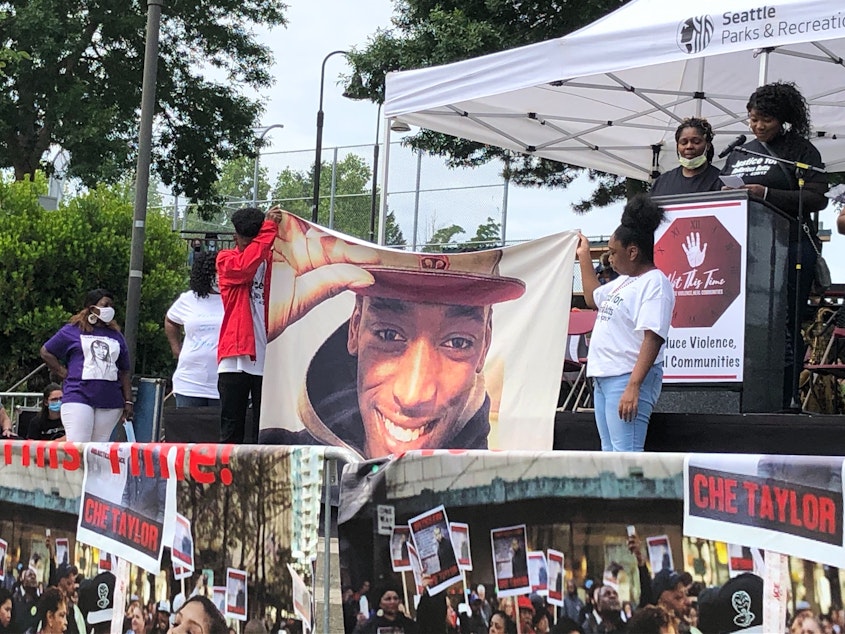Fake tombstone and Trump flag renew questions about Seattle police culture

The mother of a man who died in an encounter with Seattle police said she hopes the city will “get to the bottom” of why a fake tombstone with her son's name turned up in a recently released body-cam video. Meanwhile, the city’s Community Police Commission says SPD Chief Adrian Diaz has agreed to attend the group’s meeting next Wednesday to answer questions about the 2021 video, which showed the tombstone and a Trump 2020 banner in a police break room.
Stephanie Butts is the mother of Damarius Butts, the 19-year-old who died after exchanging gunfire with Seattle police six years ago. The exchange also left one police officer seriously injured. Stephanie Butts said she’s appreciated the memorials to people like her son who died in police encounters, which have been organized by Black Lives Matter and other movements since the murder of George Floyd by a Minneapolis police officer in 2020.
“I like the acknowledgement, people showing that they care, and that the people matter to somebody,” Butts said.
But she said she was hurt and baffled when she saw a video this week showing a fake tombstone with her son’s name on it — likely left from one of those protests — in a different context: sitting on a shelf in the Seattle Police East Precinct break room.
Butts said she could only wonder how and why the tombstone ended up there.
“What made somebody think to want to do something like that, you know?" she asked. "I know they’re saying that they don’t know who put it there, but it didn’t just walk in there.”
Sponsored
The body-cam video was recorded two years ago and came to light as a result of a separate lawsuit. It also showed a Trump 2020 flag on the wall of a room where officers were on break before heading to a call.
SPD said in a statement that both items have been removed and “have no place in a city facility.” The Office of Police Accountability is now investigating how those objects came to be there.
SPD said it has pledged “our full support to ensure OPA has all it needs for a thorough and complete record. We are reviewing our policies and procedures with respect to the maintenance and use of our facilities and will engage with OPA, OIG, and the CPC to ensure our policies are clear.”
The statement continued, “Much has changed in 2 ½ years since this footage was recorded, including a renewed commitment to relational policing and proactive engagement across all of Seattle’s diverse communities, but we know that it takes time to build trust, that trust is fragile, and that incidents like this are entirely self-inflicted wounds that set us back in those efforts and undermine the dedicated work of our members to promote the safety and wellbeing of our city.”
Adrien Leavitt is an attorney with the King County Department of Public Defense. He represented the Butts family in the county’s inquest proceeding, in which jurors found the police use of deadly force justified in Butts’ case. Leavitt said he’s dismayed by SPD’s initial statement when the video was disclosed by the Seattle Times this week.
Sponsored
SPD implied that the tombstone had simply been mislaid, saying, “It would not be unexpected that items left at the precinct might land on a storage shelf until disposition.”
Leavitt called that description misleading.
“It was prominently displayed, over a microwave, propped up," he said. "It was not something that they had collected that was on its way to the garbage.”
Leavitt also serves on the city’s Community Police Commission, in a seat reserved for public defenders, but spoke on his own behalf, not for the Commission. He said when Chief Diaz speaks with the the CPC next week, he’s eager to get more details.
“We’ll be able to ask questions about why this was allowed to happen, what this shows about Seattle Police Department’s culture, why anyone put it there, and then why others would see it and apparently nothing was done,” Leavitt said. “I think it’s not okay to say, ‘This happened then and we took it down and so it’s OK.’”
Sponsored
He said he’s most concerned with how SPD will repair the harm to the Butts family as a result of these disclosures. He said there are no ongoing legal proceedings involving the family since the inquest concluded in March 2022.
This disclosure also comes as Seattle is awaiting a decision from U.S. District Judge James Robart on the city’s motion to exit major portions of the 2012 consent decree, which found that SPD had engaged in a pattern of excessive force and showed evidence of biased policing.
The CPC said in a statement, “The culture that allows such displays and violations of policy and law have no place in any police department, especially a department seeking to come out from under federal court oversight following a pattern and practice of unconstitutional policing.”
Mayor Bruce Harrell also issued a statement, saying, “This display is an alarming and unfortunate setback that is simply unacceptable as we work to build and repair trust between our Seattle Police Department and the community."
Harrell said he supported a thorough investigation to reveal how the fake tombstone ended up on display and to prevent similar incidents happening in the future.
Sponsored
"We support OPA’s investigation and believe it’s crucial to understand who was responsible, how long these displays remained in the break room, why police supervisors didn’t recognize the problem of allowing these items to be displayed in a City facility, and how we prevent it from happening again,” he said.



